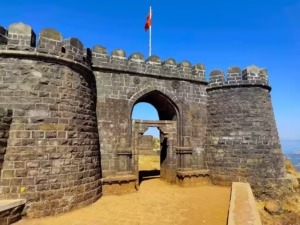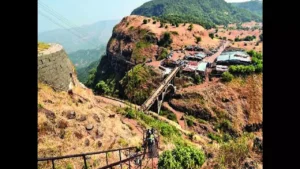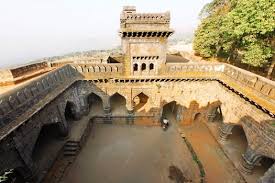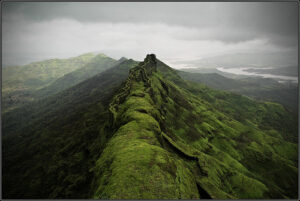Vishalgad Fort

Perched high in the Sahyadri ranges, Vishalgad Fort stands as a symbol of Maratha resilience and valor. This historic fortress played a crucial role in Chhatrapati Shivaji Maharaj’s military campaigns, serving as a strategic stronghold against enemies.
The fort’s name, meaning “Mighty Fort,” reflects its formidable presence and significance. It witnessed the legendary escape of Baji Prabhu Deshpande, who heroically defended it during the Battle of Pavan Khind, ensuring Shivaji Maharaj’s safe retreat.
Today, Vishalgad Fort attracts history enthusiasts and trekkers eager to explore its ruins, temples, and breathtaking views of the Western Ghats. The Samadhi of Baji Prabhu Deshpande remains a revered spot, reminding visitors of Maratha bravery.
With its rugged terrain and historic charm, Vishalgad Fort continues to stand as a fearless guardian of Maratha glory, echoing the tales of courage and sacrifice that shaped Maharashtra’s proud history.
Historical Significance
Vishalgad Fort, meaning “Mighty Fort”, was captured by Shivaji Maharaj in 1659. It played a crucial role in the Maratha Empire as a stronghold against the Mughals, Adilshahi Sultanate, and other invading forces. Due to its location, the fort served as a defensive and administrative center, providing a safe retreat and a base for military operations.
One of the most famous stories associated with Vishalgad is the Battle of Pavan Khind in 1660. This battle is considered one of the greatest acts of bravery in Maratha history.
The Battle of Pavan Khind and the Escape to Vishalgad
In 1660, Shivaji Maharaj was trapped at Panhala Fort by the forces of Siddi Johar, a general of the Adilshahi Sultanate. To escape the siege, Shivaji Maharaj devised a daring plan. On a stormy night, he and a small contingent of 600 soldiers, led by Baji Prabhu Deshpande, managed to break through the enemy lines and flee toward Vishalgad, their safe haven.
As they approached Pavan Khind, a narrow mountain pass, they realized that Adilshahi forces were in pursuit. To ensure that Shivaji Maharaj reached Vishalgad safely, Baji Prabhu Deshpande and 300 brave warriors stayed behind to hold off the enemy. Against thousands of Adilshahi soldiers, these valiant warriors fought relentlessly, using guerrilla tactics and their deep knowledge of the terrain to inflict heavy losses on the enemy.

Baji Prabhu’s Last Stand and the Victory at Vishalgad
Despite being vastly outnumbered, Baji Prabhu Deshpande fought with unmatched valor, holding off the enemy forces for hours. Meanwhile, Shivaji Maharaj and the remaining forces raced toward Vishalgad. Upon reaching the fort, Shivaji Maharaj ordered cannon fire as a signal of his arrival. Hearing this, the severely wounded Baji Prabhu continued fighting until his last breath, ensuring the mission’s success.
This supreme sacrifice is remembered as one of the greatest acts of loyalty and courage in Indian history. In honor of his bravery, Pavan Khind (meaning Windy Pass) was later renamed in his memory.
Vishalgad’s Role After the Battle
After securing Vishalgad, Shivaji Maharaj further strengthened its defenses, making it a key Maratha outpost. The fort served as a crucial supply point, administrative center, and refuge during conflicts with the Mughals and Adilshahi forces. Over the years, it witnessed multiple battles and strategic movements, cementing its legacy in the Maratha empire.
Even today, Baji Prabhu Deshpande’s Samadhi (memorial) at Vishalgad stands as a tribute to his undying spirit, drawing visitors who come to pay their respects to this great warrior.
Architectural Marvel
Though much of the fort is now in ruins, Vishalgad still showcases its historical grandeur. The fort is surrounded by steep cliffs, making it naturally secure. The remnants of old bastions, gateways, and fortifications speak volumes about its past. A visit to the fort reveals the Mahadev Temple, Amruteshwar Temple, and the Samadhi of Baji Prabhu Deshpande, which are revered by devotees and history lovers alike.
Fortifications and Structures
The fort is spread across a vast area, and its thick stone walls and bastions were built to withstand enemy attacks. Some of the prominent features include:
- Maha Darwaja (Main Entrance Gate): A massive stone gateway that served as the primary entrance, designed with heavy wooden doors reinforced with iron spikes to prevent elephant charges.
- Watchtowers and Bastions: Used for surveillance and defense, these bastions provided a strategic advantage to Maratha warriors.
- Hidden Escape Routes: The fort had multiple secret escape routes, allowing defenders to evacuate or launch surprise attacks against enemies.
- Storage Rooms and Water Tanks: Vishalgad had well-planned granaries, water cisterns, and reservoirs to ensure an adequate supply of food and water for prolonged sieges.
- Ruins of Residential Complexes: Traces of old palaces and residential structures indicate that the fort also housed administrative and military officials.

Temples and Religious Significance
Apart from its military importance, Vishalgad is home to several temples and spiritual sites, including:
- Mahadev Temple: A temple dedicated to Lord Shiva, showcasing ancient stone carvings and traditional Maratha architecture.
- Amruteshwar Temple: Another revered temple on the fort premises, known for its intricate carvings and spiritual significance.
- Dargah of Hazrat Malik Rehan: A shrine that signifies the fort’s diverse cultural history, visited by devotees from various faiths.
- Samadhi of Baji Prabhu Deshpande: A memorial dedicated to one of the greatest warriors of the Maratha Empire. It stands as a tribute to his unparalleled sacrifice during the Battle of Pavan Khind.
Scenic Beauty and Views
Vishalgad Fort offers stunning panoramic views of the Western Ghats, making it a paradise for photographers and nature lovers. The fort’s high altitude provides breathtaking sights of deep valleys, dense forests, and waterfalls during monsoon. The cool breeze and misty atmosphere add to its charm, making the journey to the fort a memorable experience.
Fortifications and Structures
The fort is spread across a vast area, and its thick stone walls and bastions were built to withstand enemy attacks. Some of the prominent features include:
- Maha Darwaja (Main Entrance Gate): A massive stone gateway that served as the primary entrance, designed with heavy wooden doors reinforced with iron spikes to prevent elephant charges.
- Watchtowers and Bastions: Used for surveillance and defense, these bastions provided a strategic advantage to Maratha warriors.
- Hidden Escape Routes: The fort had multiple secret escape routes, allowing defenders to evacuate or launch surprise attacks against enemies.
- Storage Rooms and Water Tanks: Vishalgad had well-planned granaries, water cisterns, and reservoirs to ensure an adequate supply of food and water for prolonged sieges.
Temples and Religious Significance
Apart from its military importance, Vishalgad is home to several temples and spiritual sites, including:
- Mahadev Temple: A temple dedicated to Lord Shiva, showcasing ancient stone carvings and traditional Maratha architecture.
- Amruteshwar Temple: Another revered temple on the fort premises, known for its intricate carvings and spiritual significance.
- Dargah of Hazrat Malik Rehan: A shrine that signifies the fort’s diverse cultural history, visited by devotees from various faiths.
- Samadhi of Baji Prabhu Deshpande: A memorial dedicated to one of the greatest warriors of the Maratha Empire. It stands as a tribute to his unparalleled sacrifice during the Battle of Pavan Khind.
Scenic Beauty and Views
Vishalgad Fort offers stunning panoramic views of the Western Ghats, making it a paradise for photographers and nature lovers. The fort’s high altitude provides breathtaking sights of deep valleys, dense forests, and waterfalls during monsoon. The cool breeze and misty atmosphere add to its charm, making the journey to the fort a memorable experience.

Best Time to Visit
The best time to visit Vishalgad Fort is during monsoon (June to September) and winter (October to February). The weather remains pleasant, and the landscapes become vibrant, making the trek more enjoyable. However, travelers should be cautious during heavy rains due to slippery trails.
- Monsoon (June to September): This is the most picturesque season to visit Vishalgad, as the fort and its surroundings are covered in lush greenery. Waterfalls, misty landscapes, and cool breezes create a magical atmosphere. However, the trails can be slippery due to heavy rainfall, so visitors must wear proper trekking shoes and carry rain gear.
- Winter (October to February): The winter months are ideal for trekking and sightseeing, with cool temperatures and clear skies. The pleasant weather allows for comfortable exploration of the fort and long trekking hours. This is also the best time for camping and stargazing.
- Summer (March to May): Summers can be harsh, with temperatures rising above 35°C. The trek can become exhausting due to the heat, and water sources dry up. However, early morning or evening visits can still be enjoyable.
For the best experience, plan your visit during the early monsoon or winter months, ensuring safety while making the most of the scenic beauty.
Trekking & Adventure
Vishalgad Fort is a popular trekking destination, offering breathtaking views of the Western Ghats. The trek is moderate in difficulty and takes visitors through dense forests, rocky trails, and scenic landscapes. The monsoon season enhances its beauty, with lush greenery covering the fort, misty surroundings, and a refreshing climate.
The trek to Vishalgad starts from Gajapur village, which serves as the base. Trekkers must navigate a steep ascent, rugged terrain, and narrow pathways, making the journey both thrilling and rewarding. The route is lined with ancient rock-cut steps, dense vegetation, and occasional water streams, especially during monsoons.
For adventure seekers, Vishalgad provides an exhilarating experience, allowing trekkers to connect with history while enjoying nature’s charm. The fort also serves as an excellent site for photography, birdwatching, and camping. The early morning mist, golden sunrise, and panoramic views from the top make it a paradise for nature lovers and photographers.
Camping at Vishalgad is a unique experience, offering starry nights and a serene environment. Visitors can set up tents near the fort ruins or by the Mahadev Temple, enjoying a night under the sky with cool mountain breezes. Trekkers are advised to carry enough food and water, as there are limited facilities available on the fort.
Wildlife enthusiasts will find the trek fascinating, as the forested trails are home to various species of birds, butterflies, and small mammals. The calls of peacocks and the occasional sighting of wild boars add an element of excitement to the journey.
The best time to undertake the trek is early morning or late afternoon to avoid the harsh sun. During monsoons, the trails can become slippery, so proper trekking shoes, raincoats, and extra precautions are necessary.
How to Reach Vishalgad Fort
Vishalgad Fort is located near Kolhapur, Maharashtra, and can be accessed via different modes of transport:
- By Road: Kolhapur is well-connected to major cities like Pune, Mumbai, and Bangalore via national highways. Travelers can take NH48 to reach Kolhapur and then hire a cab or board a state transport bus to reach Vishalgad. The nearest major town is Shahuwadi, from where the fort is about 18 km away. Private vehicles or local jeeps are the best options for the final stretch to the fort.
- By Train: The nearest railway station is Kolhapur Railway Station (Chatrapati Shahu Maharaj Terminus), around 76 km from the fort. Regular trains from Mumbai, Pune, Sangli, and Satara connect to Kolhapur. From the station, visitors can hire taxis or take buses to Gajapur or Vishalgad base village.
- By Air: The nearest airport is Kolhapur Airport, approximately 90 km away. Kolhapur Airport has limited connectivity, so travelers may prefer Pune International Airport (230 km) or Belgaum Airport (170 km) for better flight options. From the airport, one can rent a taxi or take a bus to Kolhapur and continue the journey to Vishalgad.
- By Bus: Maharashtra State Road Transport Corporation (MSRTC) runs regular buses from Pune, Mumbai, Satara, and Kolhapur to Shahuwadi or nearby villages. From there, local transport options like shared jeeps or private taxis can be used to reach the fort.

Conclusion
Vishalgad Fort is not just a historical site but a symbol of Maratha courage, sacrifice, and pride. It stands as a timeless reminder of the heroic deeds of Shivaji Maharaj and his loyal warriors. Whether you are a history enthusiast, a trekker, or a traveler seeking breathtaking landscapes, Vishalgad Fort is a must-visit destination. Explore this mighty fortress and immerse yourself in the glorious past of the Marathas.
Beyond its historical significance, Vishalgad Fort offers an experience that transcends time. It is a place where history, nature, and adventure converge, leaving visitors with a deep sense of admiration and inspiration. Standing atop its ancient walls, one can almost hear the echoes of the past, reminding us of the bravery and sacrifices that shaped Maharashtra’s legacy. A visit to Vishalgad is not just a journey through time but a tribute to the enduring spirit of the Marathas.
Follow More Fort
Vishalgad Fort Map
